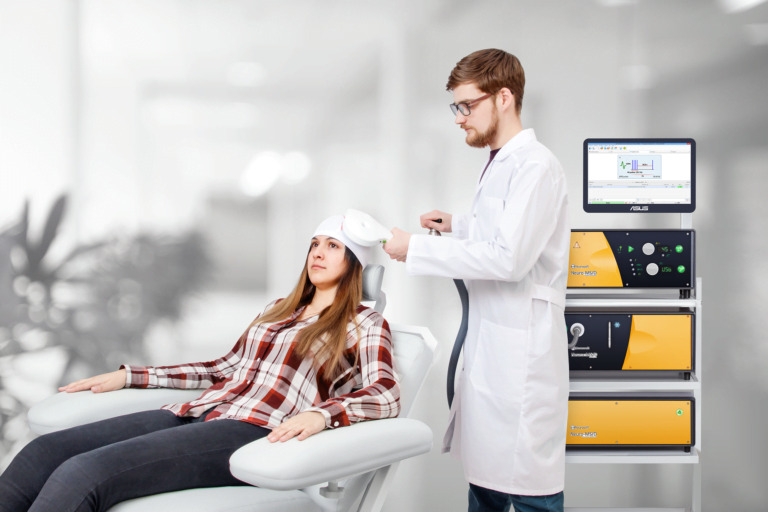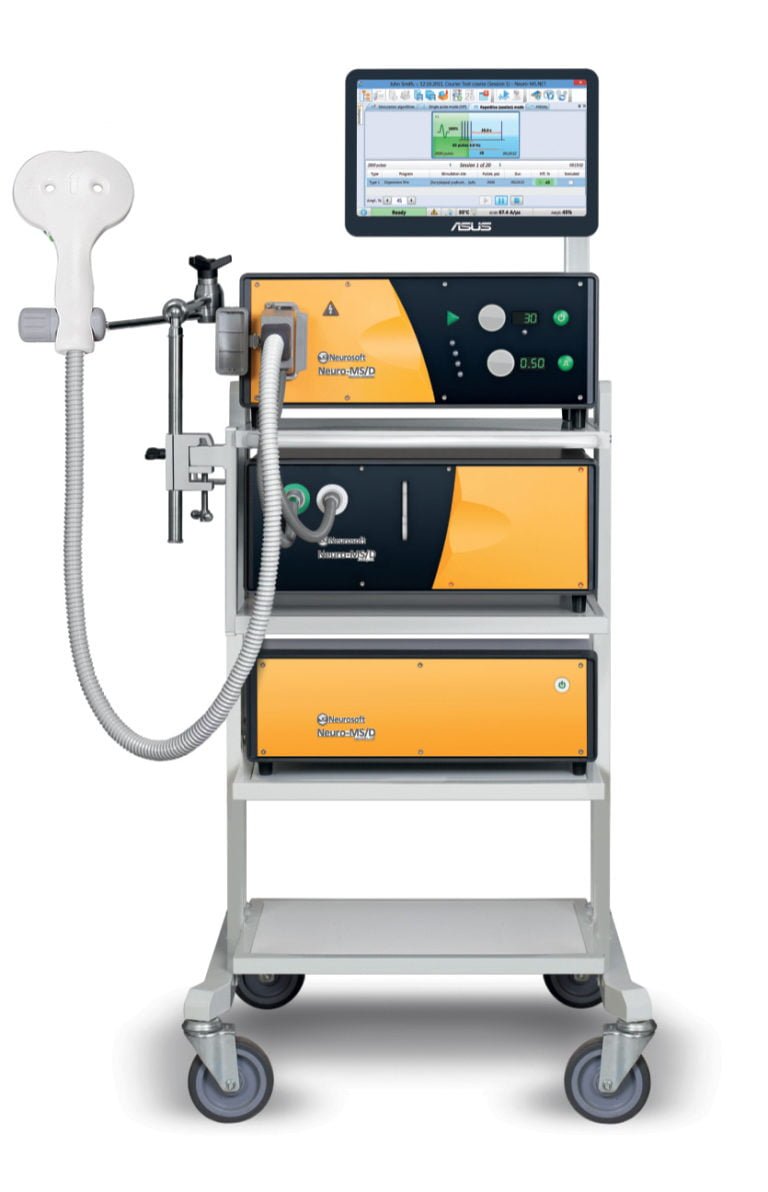- +1-856-886-8839
- contact@positivebeginnings.net
- 2003 Lincoln Drive West, Suite B, Marlton, NJ 08053
Transcranial Magnetic Stimulation (TMS)
Transcranial Magnetic Stimulation (TMS) is an FDA approved treatment for adults with treatment resistant depression, i.e. those who suffer from major depressive disorder and have failed to find relief from anti-depressants. It is an office procedure where magnetic pulses target the prefrontal cortex of the brain.
Studies have shown that almost a third of patients do not respond to traditional anti-depressants. For these patients, almost two-thirds achieve a response with TMS.
What to expect from TMS?
The Consultation:
Together with your physician, you will decide if TMS may be right for you.
You will then meet one of our therapists who will take a full history and conduct an evaluation, which will include objective tests and scales for depression, fatigue, etc. This will be done regularly during your treatment as well to monitor your progress. We will then attempt to obtain prior authorization from your insurance. Our TMS specialist and the doctor will answer any questions you may have.
Before treating your depression with TMS, your psychiatrist and the TMS Braincare team will discuss with you the possible benefits of treatment and explain what you may experience.


Treatments:
A doctor and TMS specialist will determine the location of treatment and the amount of electromagnetic pulse that will be most beneficial to you. It is done by placing a coil on your head and producing one magnetic pulse while watching for movements in the hand and fingers.
During subsequent treatments, a coil will be placed on your head. The TMS machine will be set to your specific treatment measurements. You will hear a clicking noise and feel tapping on your head.
In the first few treatments, patients may feel a mild headache.
The treatment lasts 20 minutes and is conducted daily, 5 days a week for 4-6 weeks (20-30 sessions). Some patients may benefit from maintenance therapy after their initial treatment course. Please make sure you are attending the full course of therapy to get the most benefit from treatment.
Results:
While TMS does not work for everyone, it has been found to be particularly effective for most patients. Results are often not immediate and it may take 2 or more weeks to notice improvement.
FAQ
Most Frequently Asked Questions
TMS therapy is delivered as a low-intensity procedure that lightly penetrates the skull and brain but without using invasive measures to alter the structure of the brain. TMS therapy would only be uncomfortable at higher intensities due to the tension of the scalp muscles. We take every precaution to begin our pulses at the lowest possible intensity while increasing it as necessary depending on how the brain responds to the magnetic pulses.
If the patient feels uncomfortable with the feeling of the pulses, we will dial back the intensity and consider increasing it down the road after the patient becomes more accommodated to the pressure. Headaches are the most common side effect, but these are usually temporarily reported, noting that the headaches seem to stop after the first week of treatment.
Some patients may experience discomfort even at the lower levels of intensity.
No, there is no memory loss known to correspond with TMS therapy.
The most serious risk involved in TMS therapy is the possibility of experiencing a seizure, but this is a very rare side effect. Only 1 in 10,000 patients will experience a grand mal seizure during transcranial magnetic stimulation therapy. It is important to tell your doctor if you have a history of seizures.
The most common side effect is experiencing headaches after the first two or three treatments. This is because the brain is not used to experiencing targeted magnetic pulses, much less many pulses over consecutive days. It is also not used to feeling copper coils pressed against the scalp, causing the muscles to tense up and become achy for a few days. After the first week of treatment, however, the vast majority of patients stop experiencing headaches as the scalp becomes accommodated to the twin coils and pulses.
About 20-30 treatments over the course of a month and a half; usually, the treatment involves a session every weekday, five times a week, for four to six weeks.
While TMS therapy isn’t a one-off permanent solution, it allows patients to go on for much longer periods of normalcy before experiencing depression again. Not only that, patients who relapse after TMS do not need a full sessions when they return. Some patients may benefit from ongoing maintenance therapy.
There are several key differences between these two treatments; in fact, the only thing they really have in common with one another is that they are both types of treatments designed to stimulate and regulate electrical activity within the brain.
However, as stated, there are plenty of differences to note. For one, ECT relies on a heavy usage of electricity because most of it encircles the skull since electricity doesn’t want to penetrate the solid surface. The amount of electricity applied induces intentional seizures, whereas TMS therapy is considerably less invasive and doesn’t run the same risk of damaging the brain. Nowadays, patients undergoing ECT are put under so the seizures aren’t very visible. However, in TMS therapy, no such seizures are necessary; magnetic pulses easily penetrate the skull without going very deep.
Depends on the insurance. At present most insurances do cover TMS. We also offer financing options for patients whose insurance does not cover the procedure.
Call our offices today to schedule a consultation and to find out whether or not we can accept your insurance. Even if sessions aren’t fully covered, they may be partially covered.
For the most part, just about any type of patient is capable of getting TMS therapy. There are a few exceptions, however. The following types of individuals may not qualify for TMS therapy:
Patients who have undergone brain surgery and still have magnetic metals in the brain
Patients who have never responded to other depression treatments
Very elderly patients
Patients who have seizures
No. TMS therapy is a mild outpatient course of treatment.
As a mild treatment, TMS therapy only affects about 3 centimeters deep into the brain. Although multiple pulses are given across multiple points on the head, each pulse lasts just a fraction of a second and offers very little discomfort, if any. Because the procedure is not invasive and doesn’t require any hospitalization, most patients should be able to resume normal activities immediately.
TMS is always administered under the supervision of a Physician. In general, the TMS Physician determines all the variables in the treatment, including:
Whether or not the patient is a suitable candidate for TMS Therapy
Where to administer treatment
Treatment parameters
The number of sessions the patient will need to undergo for successful treatment
Number of pulses
Although the primary physician must be the one to make the final call on treatment variables, which involve more than the above, we employ technicians who are specially trained to carry out the actual procedure according to strict guidelines. We establish a precise step-by-step guide for our technicians to follow every single time they administer the treatment, regardless of the patient. This process includes:
Placing the cap on the patient before treatment
Marking the points where magnetic stimulation will be applied
Working with the physician to adjust treatments over time
A Psychiatrist will evaluate you at least once a week while treatments are ongoing to monitor progress.
